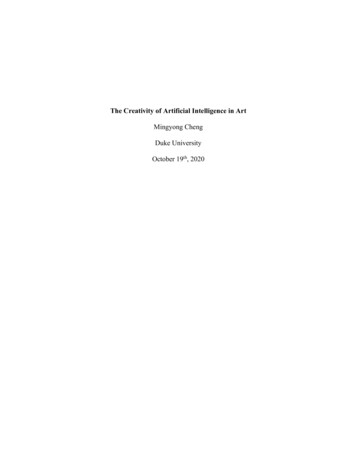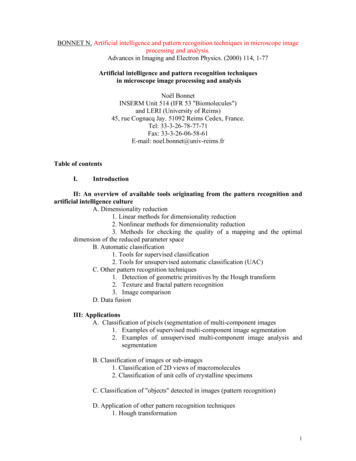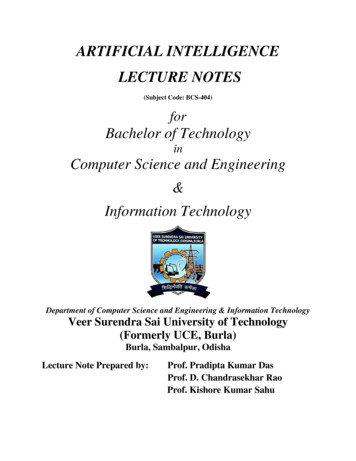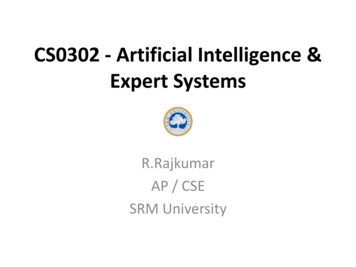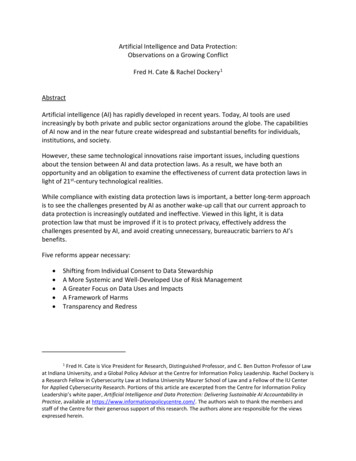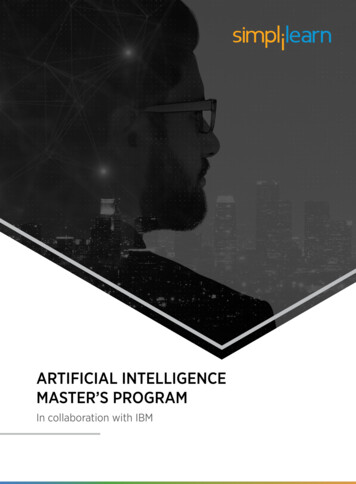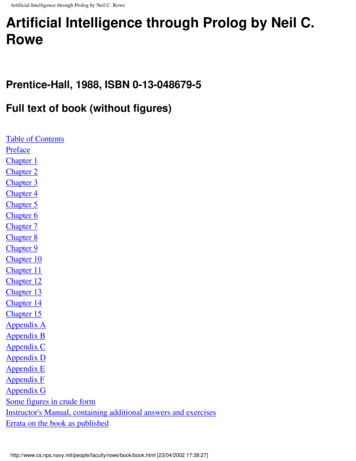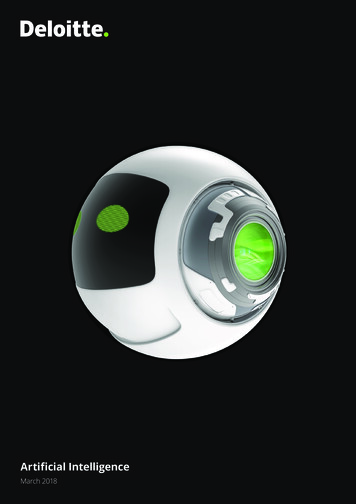
Transcription
Artificial IntelligenceMarch 2018
Proposal title goes here Section title goes here What is AI? What is MachineLearning? What is CognitiveAnalytics? How do theseterms relate, or differ, fromone another? In generalterms, AI refers to a broadfield of science encompassingnot only computer sciencebut also psychology,philosophy, linguistics andother areas.02
Artificial Intelligence ContentsContentsArtificial Intelligence Defined04Artificial Intelligence Techniques Explained10Applications of AI16Five technology trends that leap-frogArtificial Intelligence22AI opportunities for the future26Authors31Sources3203
Artificial Intelligence Artificial Intelligence defined04
Artificial Intelligence Artificial Intelligence definedArtificial Intelligence definedThe topic of Artificial Intelligence is at the top of its Hype curve1. And there aremany good reasons for that; it is exciting, promising and a bit scary at the sametime. Various publications are claiming that AI knows what we want to buy, itcan create Netflix series, it could cure cancer and it may eventually take ourjobs or even destroy mankind.2The problem and at the same timeopportunity with AI is that it’s not very welldefined. If we would show the navigationsystem of our car to someone living in1980, he or she would probably consider itas a form of Artificial Intelligence, whereaswe nowadays would probably not. We areseeing the same with speech and imagerecognition, natural language recognition,game engines and other technologies thatare becoming more and more commonand embedded in every-day technology.On the other hand, various technologysolution providers are taking theopportunity to rebrand their existingsolutions to AI, to take advantage ofthe huge hype and that the market isexperiencing and the resulting presscoverage. If we have a built a machinelearning model that predicts customerdemand, a solution that has been existingfor years, we would have called it “datamining” in the past and we now see itrebranded as “artificial intelligence”. This isadding to the confusion and may very welllead to inflated expectations.Nevertheless, recent developments inAI are impressive and exciting. But alsooverestimated and misunderstood. Inorder to split hype from reality and helpforming a view on this market, we willpublish a series of articles explaining theworld of AI, zooming in to the techniquesthat are associated with AI, the mostappealing business applications andpotential issues we can expect.In this first article we will start with thebeginning, by explaining AI and associatedterms in five definitions. What is AI? Whatis Machine Learning? What is CognitiveAnalytics? How do these terms relate, ordiffer, from one another?.“AI refers to a broad fieldof science encompassingnot only computer sciencebut also psychology,philosophy, linguistics andother areas”Artificial Intelligence (AI)In general terms, AI refers to a broadfield of science encompassing not onlycomputer science but also psychology,philosophy, linguistics and other areas.AI is concerned with getting computersto do tasks that would normally requirehuman intelligence. Having said that, thereare many point of views on AI and manydefinitions exist. Below some AI definitionswhich highlight key characteristics of reoflife.org/ai-open-letter/1205
Artificial Intelligence Artificial Intelligence definedBIG DATAREASONINGCapable of processing massiveamounts of structured andunstructured data which canchange constantlyAbility to reason (deductive orinductive) and to draw inferencebased to the situation. Contextdriven awareness of the system.Ability to learn based on historicalpatterns, expert input andfeedback loopCapable of analyzing andsolving complex problems inspecial-purpose and generalpurpose domainLEARNINGPROBLEM SOLVINGFigure 1: Key characteristics of an AI systemSome general definitions: “Artificial intelligence is a computerizedsystem that exhibits behavior thatis commonly thought of as requiringintelligence.”3 “Artificial Intelligence is the science ofmaking machines do things that wouldrequire intelligence if done by man.” 4The founding father of AI Alan Turingdefines this discipline as: “AI is the science and engineering ofmaking intelligent machines, especiallyintelligent computer programs”. 5In all these definitions, the concept ofintelligence refers to the ability to plan,reason and learn, sensing and buildingsome kind of perception of knowledge andcommunicate in natural language.Narrow AI vs General AIA chess computer could beat a humanin playing chess, but it couldn’t solve acomplex math problem. Virtually all currentAI is “narrow”, meaning it can only do whatit is designed for. This means for everyproblem, a specific algorithm needs to bedesigned to solve it. Narrow AI are mostlymuch better at the task they were made forthan humans, like face recognition, chesscomputers, calculus, translation. The holygrail of AI is a General AI, a single systemthat can learn about any problem and thensolve it. This is exactly what humans do:we can specialize in a specific topic, fromabstract maths to psychology and fromsports to art, we can become experts at allof them.An AI system combines and utilizes mainlymachine learning and other types of dataanalytics methods to achieve artificialintelligence capabilities.Preparing for the Future of Artificial Intelligence, NSTC, 20166. Raphael, B. 1976. The thinking computer. San Francisco, CA: W.H. ai/node1.html3406
Artificial Intelligence Artificial Intelligence definedArtificial IntelligenceAbility to sense, reason, engageand learnComputer visionRobotics & hine LearningAbility to learnUnsupervised learningSupervisedlearningPlanning MethodsAbility to reasonRegressionDecision treesetc.TechnologiesPhysical enablementPlatformUXAPIsSensorsetc.Figure 2: relation between AI, Machine Learning and underlying methods and infrastructureMachine LearningMachine learning is the process wherebya computer distills meaning by exposureto training data6. If for example you wantan algorithm to identify spam in e-mails,you will have to train the algorithm byexposing it to many examples of e-mailsthat are manually labeled as being spam ornot-spam. The algorithm “learns” to identifypatterns, like occurrence of certain wordsor combination of words, that determinesthe chance of an e-mail being spam.Machine learning can be applied to manydifferent problems and data sets. You cantrain an algorithm to identify pictures ofcats in photo-collections, potential fraudcases in insurance claims, transformhandwriting into structured text, transformspeech into text etc. All these exampleswould require labeled training sets.6Depending on the technique used, analgorithm can improve itself by adding afeedback loop that tells it in which cases itmade mistakes.The difference with AI however is thata machine learning algorithm will never“understand” what it was trained to do. Itmay be able to identify spam, but it will notknow what spam is or understand why wewant it to be identified. And if there is anew sort of spam emerging, it will probablynot be able to identify it unless someone(human) re-trains the algorithm.Machine learning is at the basis of mostAI systems. But while a machine learningsystem may look “smart”, in our definitionof AI it is in fact not.Cognitive AnalyticsCognitive Analytics is a subset of A.I.that deals with cognitive behavior weassociate with ‘thinking’ as opposed toperception and motor control. Thinkingallows an entity to obtain information fromobservations, learn and communicate.A cognitive system is capable of extractinginformation from unstructured data byextracting concepts and relationships intoa knowledge base. For example, from a textabout Barack Obama, the relations fromFigure 3 can be extracted using NaturalLanguage Processing. 80% of all companydata is unstructured and current CognitiveAnalytics systems can search all of it to findthe answer to your question.Stephen Lucci, 2016, Artificial intelligence in the 21st century : A living introduction07
Artificial Intelligence Artificial Intelligence definedMexicoNeighbourUSAPresidentBarack ObamaSpouseFatherMichelle ObamaFatherMotherMotherMalia ObamaSibblingSasha ObamaFigure 3: A knowledge base extracted from textLearning enables the Cognitive Systemto improve over time in two major ways.Firstly, by interacting with humans, andobtaining feedback from the conversationpartner or by observing two interactinghumans. Secondly, from all the data in theknowledge base, new knowledge can beobtained using inference.User:AI:User:AI:Another important aspect of CognitiveAnalytics is the ability to use context.Context enables a Cognitive Analyticssystem to infer meaning from language. Forexample, a chatbot can take into accountthe conversation history to infer who isreferred to by the word he:Who is Obama’s wife?Michelle Obama.How old is he?Barack Obama is 55 years old.Figure 4: Example conversation of a cognitive system08
Artificial Intelligence Artificial Intelligence definedFor this simple exercise, the system needsto be aware of names that representpeople, relationships between people,gender and the common sense to inferthat Obama refers to Barack Obama. All ofthis contextual information is required tomake the right inferences to answer bothquestions.Since Cognitive Systems are aware ofcontext, can understand unstructureddata and reason about information, theycan communicate with humans as well.This enables the system to understanda question posed in English, no longerrequiring the time-consuming process ofconverting the question into a format thecomputer can work with. For example,a call center representative cognitivesystem can quickly answer a customer’squestion about camping gear by usinginformation from product descriptions,customer reviews, sales histories, topicalblogs, and travel magazines.7 CognitiveSystems can understand and communicatethrough many mediums, including speech,image, video, sign language, graphs or anycombination of these.RoboticsAI is an important enabling factor in designand operationalizing smart robots andother process automation applications.In its most simple form, a robot may be amachine that is programmed to performa simple task, by following step-by-stepinstructions. It could consist of a rule-basedengine that explicitely tells the system whatto do when a certain condition occurs. Arobot in a car factory Is programmed likethat and hardly considered “intelligent”.But robotics exist in a variety of much moreintelligent shapes, ranging from unmannedautonomous vehicles (UAV’s), drones, smartvacuum cleaners to intelligent chatbots andsmart assistants etc. How advanced robots78910are is vivid if we look at robots developedby Boston Dynamics8 and MIT’s Cheetah II9.Other example is Amelia10, an intelligentassistant with NLP capabilities. Key aspectof robotics is that it combines hardware(mechanical parts, sensors, screens etc.)with intelligent software and data toperform a task for which certain level ofintelligence is required (e.g. orientation,motion, interaction etc.).Smart MachinesThe major theme in using the term “SmartMachines” is autonomy. Smart Machinesare systems that –to some extend- are ableto make decisions by themselves, requiringno human input. Cognitive Analyticssystems can be Smart Machines, as wellas robots, or any kind of AI, as long as itadheres to this rule. In the case of a robot,autonomy could consists of a capability toplan where it wants to go, what it wants toachieve and how to overcome obstacles.Rather than being human-controlled orsimply following instructions, it couldachieve higher-level goals like gettinggroceries, inspecting buildings and so forth.This is enabled by planning methods, selfpreservation instincts on top of the skillsthat a normal robot already requires.In the case of a Cognitive System, it willpro-actively try to learn new facts, gaugeopinions and learn new common senserules by engaging in active conversationwith humans, asking questions anddouble-checking them with data foundonline. It will also actively inform decisionmakers about changes it has observed, forexample if the opinion of customers onsocial media suddenly makes a swing. Itcould even act upon these changes, in theexample engaging with the customers orsharing the positive opinions on the socialmedia outlets of the company.Since Smart Machines are autonomous andintelligent, they might start communicatingamong themselves. This leads to multiagent systems that can make tradesto improve their utility. The buildinginspecting robot can ask a drone to inspectthe roof for him, trading this favor foranother favor, like transporting goods orsimply currency.A Cognitive System that becomes a SmartMachine can specialize in a specific area,becoming an expert in that area. Now,other Smart Machines can ask it forinformation in that area, and it will be ableto provide more relevant answers morequickly than a general Cognitive Systemthat is not specialized. Information brokerslike this improve the overall utility of thewhole network of Smart Machines.ConclusionThe terms Machine Learning, Cognitive,Robotics and smart machines are usedoften in relationship to AI, or sometimeseven as synonyms. AI is a complex fieldof interest, with many shapes and forms.Therefore we have tried to shine somelight on the most used terminology. Insubsequent blogs, we will dive deeper intechniques behind AI systems, businessapplications, some associated technologytrends and the top 5 risks and concerns.Deloitte, Cognitive analytics The three-minute ah-2http://www.ipsoft.com/amelia/09
Artificial Intelligence Artificial Intelligence techniques explained10
Artificial Intelligence Artificial Intelligence techniques explainedArtificial Intelligencetechniques explainedIn order to ‘demystify’ Artificial Intelligence, and in some way get more peopleinvolved in AI, we are publishing a series of articles explaining the world of AI,zooming in on the techniques that are associated with AI, the most appealingbusiness applications, and potential issues we can expect.The first blog article explained some ofthe most commonly used definitions ofAI. In this second article we will explainsome fundamental AI techniques used:Heuristics, Support Vector Machines,Neural Networks, Markov Decision Process,and Natural Language Processing.HeuristicsSuppose we have coins with the followingdenominations: 5 cents, 4 cents, 3 cents,and 1 cent and we need to determine theminimum number of coins to get 7 cents.In order to solve this problem we can makeuse of a technique called “heuristics”.Webster1 defines the term Heuristicas “involving or serving as an aid tolearning, discovery, or problem-solvingby experimental and especially trial anderror methods”. In practice, this meansthat whenever problems get too large ortoo complex to find the guaranteed bestpossible solution using exact methods,heuristics are a way to employ a practicalmethod to find a solution that is notguaranteed to be optimal, but one that issufficient for the immediate goals.For some problems, tailored heuristicscan be designed that exploit the structurepresent in the problem. An example ofsuch a tailored heuristic would be a greedyheuristic for the above mentioned coin-123changing problem. Now a greedy heuristicwould be to always choose the largestdenomination possible and repeat thisuntil we get to the desired value of 7. Inour example, that means that we wouldstart with first selecting one 5 cent coin.For the remaining 2 cents, the largestdenomination we can choose is 1 cent,leaving us with the situation where we stillhave to cover 1 cent for which we againuse 1 cent.So our greedy heuristic gives us a solutionof 3 coins (5, 1, 1) to get to the value of7 cents. It can be easily seen that another,better, solution of only 2 coins exist usingthe 3 and 4 cent coins. While the greedyheuristic for the coin changing problemdoes not provide the best solution for thisparticular case, in most cases it will result ina solution that is acceptable.Besides such tailored heuristics for specificproblems, also certain generic heuristicsexist. Just like neural networks, some ofthese generic heuristics are based onprocesses in nature. Two examples ofsuch generic heuristics are Ant ColonyOptimization2 and genetic algorithms3.The first is based on how simple ants areable to work together to solve complexproblems and the latter is based on theprinciple of survival of the /heuristichttps://en.wikipedia.org/wiki/Ant colony optimization algorithmshttps://en.wikipedia.org/wiki/Genetic algorithm11
Artificial Intelligence Artificial Intelligence techniques explainedFigure 1132Figure 3Figure 2A typical problem where heuristics areapplied to find acceptable solutions quicklyis vehicle routing, where the objective is tofind routes for one or more vehicles thathave to visit a number of locations.the boundary line creates a maximumseparation between the classes. Todemonstrate this, we will use the followingsimple data for our classification problem(Figure 1).Support Vector MachinesThe question whether an email is spam ornot spam is an example of a classificationproblem. In these types of problems, theobjective is to determine whether a givendata point belongs to a certain class or not.After first training a classifier model on datapoints for which the class is known (e.g.a set of e-mails that are labeled as spamor not spam), you can then use the modelto determine the class of new, unseendata-points. A powerful technique forthese types of problems is Support VectorMachines4 (SVM).In this example, the green circles and thered squares could represent two differentsegments in a total set of customers (e.g.high potential and low potential), basedon all kinds of properties for each of thecustomers. Any line that keeps the greencircles on the left and the red squares onthe right is considered a valid boundaryline for the classification problem. Thereis an infinite number of such lines that canbe drawn and 4 different examples arepresented on top (Figure 2).The main idea behind SVM is that you tryto find the boundary line that separatesthe two classes, but in such a way that4https://en.wikipedia.org/wiki/Support vector machine12As stated before, with SVM you try to findthe boundary line that maximizes theseparation between the two classes. Inthe provided example, this can be drawnas Figure 3:The two dotted lines are the two parallelseparation lines with the largest spacebetween them. The actual classificationboundary that is used will be the solidline exactly in the middle of the twodotted lines.The name Support Vector Machine comesfrom the data points directly on either ofthese lines are the supporting vectors. In ourexample, we had 3 supporting vectors.If any of the other data points (i.e. not asupporting vector) is moved slightly, thedotted boundary lines are not affected.However, if the position of any of thesupporting vectors is slightly changed (e.g.data point 1 is moved slightly to the left),the position of the dotted boundary lineswill change and therefore the position ofthe solid classification line also changes.
Artificial Intelligence Artificial Intelligence techniques explainedIn real life, data is not as straightforwardas in this simplified example. Wenormally work with much more thantwo dimensions. Besides havingstraight separation lines, the underlyingmathematics for an SVM also allows forcertain type of calculations or kernels thatresult in boundary lines that are non-linear.Biological neuronArtificial neuronX1X2OutputX3SVM classification models can also befound in image recognition, like facerecognition or converting handwritingto text.Artificial Neural NetworksAnimals are able to process (visual or other)information from their environment andreact adaptively to a changing situation.They use their nervous system to performsuch behavior. Their nervous system canbe modeled and simulated and it should bepossible to (re)produce similar behavior inartificial systems. Artificial Neural Networks(ANN) can be described as processingdevices that are loosely modeled after theneural structure of a brain. The biggestdifference between the two is that theANN might have hundreds or thousandsneurons, whereas the neural structure ofan animal or human brain has billions.The basic principle of a neural structureis that each neuron is connected witha certain strength to other neurons.Based on the inputs taken from theoutput of other neurons (also consideringthe connection strength) an output isgenerated which can be used as inputagain by other neurons, see Figure 1 (left).This basic idea has been translated into anartificial neural network by using weightsto indicate the strength of the connectionbetween neurons. Furthermore, eachneuron will take the output from theconnected neurons as input and use amathematical function to determine itsoutput. This output is then used by otherneurons again.5Figure 4: Graphical representation of a biological neuron (left) and an artificialneuron (right)Where in the biological brain learning takesplace by strengthening or weakening thebonds between different neurons, in theANN the learning takes place by changingthe weights between the neurons. Byproviding the neural network with a largeset of training data with known features thebest weights between the artificial neurons(i.e. strength of the bond) can be calculatedin order to make sure the neural networkbest recognizes the features.The neurons of the ANN can be structuredinto several layers5. Figure 5 shows anillustrative scheme of such layering. Thisnetwork consists of an input layer, whereall the inputs are received, processed andconverted to outputs to the next layers.The hidden layers consist of one or morelayers of neurons each passing throughinputs and outputs. Finally, the output layerreceives inputs of the last hidden layer andconverts this to the output for the user.Figure 2 shows an example network whereall neurons in one layer are connectedto all neurons in the next layer. Such anetwork is called fully connected. Dependingon the type of problem you want to solvedifferent connection patterns are available.For image recognition purposes, typicallyHidden layersOutput layerInput layerFigure 5: Schematic of a connected html13
Artificial Intelligence Artificial Intelligence techniques explainedConvolutional networks are used, whereonly groups of neurons from one layer areconnected to groups of neurons in the nextlayer. For speech recognition purposes,typically Recurrent networks are used, whichallow for loops from neurons in a later layerback to an earlier layer.Markov Decision ProcessA Markov Decision Process (MDP) is aframework for decision-making modelingwhere in some situations the outcomeis partly random and partly based onthe input of the decision maker. Anotherapplication where MDP is used is planning,where the planning is optimized. Thebasic goal of MDP is to find a policy for thedecision maker, tells him which particularaction should be taken at which state.An MDP model consists of thefollowing parts6: A set of possible states: for example,this can refer to a grid world of a robotor the states of a door, door open anddoor closed. A set of possible actions: a fixed set ofactions a robot for example can take,such as going north, left, south or west.Or with respect to a door, closing oropening door. Transition probabilities: this is theprobability of going from one state toanother state. For example, what isthe probability that the door is closed,after the action of closing the dooris performed. Rewards: these are used to guide theplanning. With respect to the robot andthe grid example, a robot may want tomove north to reach its destination.Actually going north will result in ahigher reward.67https://www.cs.rice.edu/ nt 224.html14 Once the MDP is defined, a policy can betrained using “Value iteration” or “PolicyIteration”. These methods calculate theexpected rewards for each of the states.The policy then gives the best action thatcan be taken from each state.-1 3-3-1As an example, we will define a grid whichcan be seen as an ideal, finite world fora robot7. This example grid is shown inFigure 6.The robot can move (action) from eachposition in the grid (state) in four directions,namely north, left, right and south. Theprobability that the robot goes into thedesired direction is 0.7 and 0.1 if it goestowards any of the other 3 directions. Areward of -1 (i.e. a penalty) is given if therobot bumps into a wall and doesn’t move.Also, additional rewards and penalties aregiven if the robot reaches the cells that arecolored green and red, respectively. Basedon the probabilities and rewards a policy(function) can be made using the initial andfinal state.Another example where MDP can beused is the inventory planning problem,where a stock keeper or manager eachweek has to decide how many units haveto be ordered. The inventory planning canbe modeled as an MDP, where the statescan be considered positive inventory andshortages. Possible actions are for instanceordering new units or backlogging to thenext week. Transition probabilities can beconsidered as the action that will be takenbased on the demand and inventory forthe current week. Rewards, or in this case,costs are typically unit order costs andinventory costs.-1-10 10-1Figure 6: Example – grid world ofa robotNatural Language ProcessingNatural Language Processing, or NLP inshort, is a term for everything from speechrecognition to language generation, eachrequiring different techniques. A few ofthe important techniques will be explainedbelow, which are Part-of-Speech tagging,Named Entity Recognition, and Parsing.Let us examine the sentence “John hitthe can.” One of the first steps of NLP islexical analysis, here a technique is usedcalled Part-of-Speech (POS) tagging. Withthis technique every word is tagged tocorrespond to a category of words whichhave similar grammatical properties,based on its relationship with adjacent andrelated words. Not only words are tagged,but also paragraphs and sentences. Partof-speech tagging is mainly done withstatistical models, which give probabilisticresults instead of hard if-then rules, andis therefore more capable of processingunknown text. Also, they can cope with thepossibility of multiple possible answers,instead of only one. A technique which isoften used for tagging is a Hidden Markov
Artificial Intelligence Artificial Intelligence techniques explainedModel (HMM). An HMM is similar to theMarkov Decision Process, where each stateis a part of speech and the outcome ofthe process is the words of the sentence.HMM’s ‘remember’ sequences of wordsthat came before and can, based on this,make better estimates of what POS aword is. For example: ‘can’ in ‘the can’, ismore likely to be a noun than a verb. Theend result is that the words are tagged asfollowed: ‘John’ as a noun (N), ‘hit’ as a verb(V), ‘the’ as a determiner (D) and ‘can’ as anoun (N) as well.Named Entity Recognition or NER, is similarto POS tagging. Instead of tagging wordswith what function the word has in thesentence (POS), words are tagged withthe type of entity the word represents.These entities can be for example person,company, time, location, etc. But alsomore specialized entities such as gene,or protein. Although an HMM can also beused for NER, the technique of choice is aRecurrent Neural Network (RNN). An RNNis a different type of neural network asdiscussed earlier, but it takes sequencesas input, that is a number of words ina sentence, or complete sentences,and remembers the output from theprevious sentence.8 In the sentence weare looking at, it will recognize John as theentity ‘person’.8A final technique to be discussed is calledParsing (Syntactic Analysis). With parsing,the text is analyzed for grammar andthe arranging of the words so that therelationship between the words is clear.This is done by using the Part-of-Speech tagfrom the lexical analysis and then groupingthese into small phrases, which in turn canalso be combined with other phrases orwords to make a slightly longer phrase. Thisis done until the goal is reached: to haveused every word in the sentence. The ruleshow the words can be grouped are calledthe grammar and can take a form like this:D N NP, which reads: a Determiner Noun Noun Phrase. The final result isdepicted in the figure 7.SNVPVJohnhitNPDNthecan.Figure 7ConclusionThe techniques used within the domainof Artificial Intelligence are, when youdive into them, just advanced forms ofstatistical and mathematical models. Allthese models cleverly put together give ustools to compute tasks, previously thoughtto be reserved for humans. In subsequentblogs we will dive deeper in businessapplications, some associated technologytrends, and the top 5 risks and concerns.More on RNN: ness/15
Artificial Intelligence Applications of AI16
Artificial Intelligence Applications of AIApplications of AIIn order to ‘demystify’ Artificial Intelligence (AI), and in some way get morepeople involved in it, we are publishing a series of articles explaining theworld of AI, zooming in on the techniques that are associated with it, the mostappealing business applications, and potential issues.In our second blog article, we coveredsome fundamental AI techniques
"Artificial intelligence is a computerized system that exhibits behavior that is commonly thought of as requiring intelligence."3 "Artificial Intelligence is the science of making machines do things that would require intelligence if done by man." 4 The founding father of AI Alan Turing defines this discipline as:
